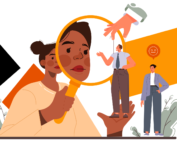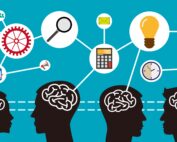One of the biggest challenges for many organisations is how to remain competitive in an ever-changing world. Design Thinking is a popular method for teams and organisations looking to embrace innovation and adaptability and find new solutions to old, tricky problems.
What Is Design Thinking?
Design thinking is a standardised approach which is intended to address ‘wicked problems’. These are problems that are ill-defined and difficult to combat. The method is used to help solve problems through a person-centred, design mind-set. The concept is typically associated with David Kelly of IDEO, but actually has origins in Herbert Simon’s 1969 book ‘the Science of the Artificial’, and is normally associated with physical product design.
However, design thinking can actually be used to solve a wide range of businesses challenges, even if the product you provide users isn’t a physical one.
Depending on the source you choose there are normally four of five stages to design thinking; below we outline the five-stage approach and investigate how each phase could help L&D create better learning interventions for employees.
Stage One – Empathise
In this phase you spend time understanding the current experience of the users you support. Regardless of whether you provide a physical product or a service to your customers, you need to spend time using it as if you were a customer. This includes using the current tools, processes and support available to help you understand where frustrations lie.
At this stage you’ll also want to gather feedback from the users themselves. Once you understand where individuals are coming from you can start to build a better picture of what the problem is, which leads directly to the next stage.
Stage Two – Define the Problem
For any product or service, there will likely be a range of areas where change may be needed, and it may be that the solution needs to address any one of these, or several. Is the problem a clunky and difficult to navigate system, are there practical limitations of your product for certain users?
This stage of the process works best with the involvement of a diverse range of people, including users, operations, managers, and other relevant stakeholders. Get everyone together to understand the fundamental problem(s); keep breaking it down until everything you think possible has been addressed, and then find a way to define it. The definition of the problem is extremely important as it will inherently influence the solution you subsequently develop. Keep re-working the definition until something evolves that really focuses on the fundamental need.
Stage Three – Come up with Ideas
This can be one of the most fun stages of the process as it is an opportunity for everyone to throw up suggestions with wild abandon; there should be no limits or boundaries placed on the ideas no matter how weird, wonderful or wacky they may seem initially. As with the definition stage, a diverse range of individuals should be involved to help generate the most ideas possible. Having a wide range of options to choose from, based on a variety of perspectives, will ensure the best potential solutions can later be identified.
Stage Four – Prototype
The ideas identified in stage three can then be further refined and re-assessed until the most appropriate and feasible ideas are picked out and prototyped where possible. This isn’t always easy as many of the solutions may be theoretical at this stage, however finding ways to trial solutions before deciding on the best one(s) will help reduce delays and extra cost down the line.
In some instances the ideas identified in stage three may ultimately turn out to be impractical, and it may be that an alternative solution would be better. The only way to know for sure is to test it out; of course this isn’t always simple to do, especially when seeking to implement a wide scale business change. However, finding ways to experiment with ideas before they are fully rolled-out will be incredibly important to prevent time and money being unnecessarily wasted. This may require the use of pilot programmes, focus groups or user experience tests, and if desired outcomes aren’t met, it may be that stage three needs revisiting and further solutions explored.
Stage Five – Test and Implement
This is the stage where the most promising ideas are developed and rolled-out, but it’s important to be aware that this remains a testing phase as well. While as much as possible should have been done to iron out any issues during the first four stages, it may be that unforeseen outcomes or drawbacks do come to light, so it’s important to maintain vigilance to identify and rectify any challenges that arise. These may not be issues that can be resolved immediately, but they certainly need to be noted for future progress.
Again, at this stage you need to make sure that you are gathering feedback and views on the new solution. This will enable action to be taken more swiftly in the event of any problems, and help limit any further disruption.
Building a new product or service, or redesign an existing one, is a complex challenge; there are a lot of elements that require consideration such as the needs of your users, the strategic vision of the business, costs, resources and desired outcomes. But these issues are exactly why many organisations can benefit from using an alternative approach to creative thinking and product/service design. Using a Design Thinking approach can help break down barriers and enable more innovative solutions to come to light. However, Design Thinking isn’t the only approach available; depending on your needs, there are many methods and tools that can be used to help promote more innovative solutions to emerge that will help drive business growth and delight your users.
Alternatively, find out more about our Design Thinking for Innovation course, which takes you through all of the stages mentioned above, giving you the practical experience to run your own design thinking sessions. For full details, check out the course outline here, or contact us to find out more.
Read Next
Soft Skills: Why Being a Control Freak is Hurting Your Project Management Success
Are you a project manager who feels the need to be in control of every aspect of your project? While being detail-oriented and organised can be beneficial, it's important to recognise when your inner [...]
Becoming a Presenting Powerhouse: Mastering The Trifecta of Effective Presentations
Many people assume that some people are just born presenters. But we’re here to let you into a little secret - ANYONE can be a great presenter. And the best part? It isn’t even hard [...]
L&D and HR: A Force to Be Reckoned With
It’s an unfortunate truth, but in many organisations L&D and HR often don’t work well together. Despite the fact that the two functions are traditionally working towards the same goal, there remains a great [...]
Marketing and Communications in L&D
It doesn’t matter how good (or bad) your L&D offering is, if nobody knows it’s there, then it might as well not exist. As learning and development has evolved in its capacity and influence [...]
The death of the linear career path and what it means for professional development
Unlike career routes available in the past, very few people these days will follow a linear career path – it’s no longer about moving up, but moving around. But if people want to be [...]
Skills assurance in a dynamic workplace
With employees taking advantage of more fluid careers, organisations need to have plans in place to address the constant flux occurring within the workplace. One approach is ‘skills assurance’, but what is skills assurance, [...]






